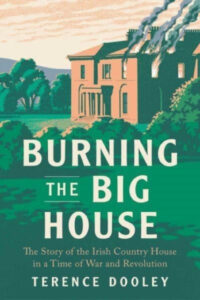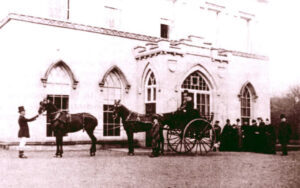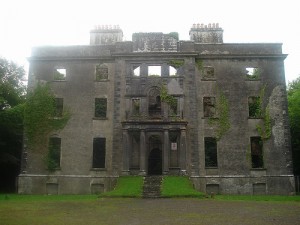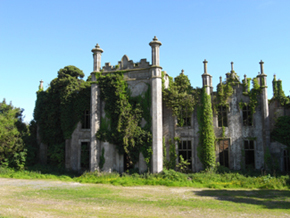Review: Burning the Big House, the Story of the Irish Country house in Time of War and Revolution
 By Terence Dooley
By Terence Dooley
Published by Yale University Press, New Haven 2022
Reviewer: John Dorney
Terence Dooley has devoted much of his historical career to the study of the ‘Big House’ or country mansion and associated aristocracy in Ireland. His seminal ‘The decline of the Big House in Ireland’ (2001) opened the way for many future examinations of the topic. Here he focuses specifically on the burnings of the ‘Big Houses’ during the Irish revolutionary period (1912-1924) and particularly during the Civil War of 1922-23.
The burning of the country mansions of Ireland’s former landed elite, mostly by the IRA, has drawn much interest in recent years. The imagery of the great mansion, which had once dominated vast swathes of the Irish countryside going up in flames is certainly spectacular. A perception exists among the public that all or most of the ‘Big Houses’ of Ireland were burned down in this period in a vengeful orgy of violence. However, as Dooley shows here, destruction due to revolutionary violence destroyed roughly 300 such mansions out of, by his count, about 1,500 or about 20%. Other accounts, for instance Diarmuid Ferriter’s recent history of the Civil War, ‘Between Two Hells’ cites an even smaller percentage – four per cent.
Perhaps the uncertainty is due to how a ‘Big House’ in Ireland is defined. Should we count only those mansions which were, or had been, the scions of great country estates of titled aristocrats? Or should we include also the palatial houses of those without title? Or those – the Guinness and Jameson families are two prime examples – who had made their money through industry, become titled and only afterwards constructed country houses as status symbols?
This is not made completely clear in this book. But it does seem as if Terence Dooley’s main focus is indeed on those families and houses who were both titled and landed. As the book is intended for an international as well as an Irish audience, Dooley explains that the majority of such families were Protestant in religion, sometimes with roots in Ireland going back to the 17th century plantations or other confiscations and generally with strong ties to England where they often also held land or were resident. These gave rise to the often-pejorative terms ‘Anglo-Irish’ or ‘Protestant Ascendancy’ for the landed aristocracy: terms often employed by Irish nationalists but which Dooley himself does not use.
Nevertheless he does show how this group kept themselves apart from the majority Catholic population and (with some exceptions, notably the Parnell and Childers-Barton families of Wicklow or Maurice Moore of Mayo) opposed the pursuit of Irish self-government.
From Land War to Great War

The book is divided into three sections, first before the days of the ‘Land War’ in the late 19th century up to the end of the First World War, then ‘burning the big house’ from 1920-23 and finally on the aftermath, ‘destruction, looting and compensation’.
Dooley explains cogently that from the era of the Land Acts of the 1880s, the days of the great landed estate and the attendant Big House were probably numbered in Ireland. Gladstone’s land acts made it very difficult to raise tenants’ rents or to evict them and the Wyndham Act of 1903 enabled many tenant farmers to buy their own land at market price with subsidised loans from the British government.
He argues, again persuasively, that this represented a great missed opportunity for the old landed class. With a one-off windfall of money from the sales (and some 70 per cent of the landed families had availed of the sale prior to the Great War) they could have invested in agriculture in their demesne lands or in local industry, securing their financial future. But only a minority did so. Most were so accustomed to large income from their estates and to a culture of conspicuous consumption and paternalistic employment that they were unable to become rural businesspeople.
Therefore, and this is an important point, the economic ‘decline of the Big House’ was already well underway before the Irish revolution commenced.
Many ‘Big House’ grandees helped to mobilise unionist opposition to Home Rule in 1912-14 and the young men of this class suffered greatly and disproportionately in the casualties of the First World War. The letters detailing the latter are one of the most poignant sections of this book.
The meat of the book however, is the middle section, ‘burning the Big Houses’ concerning destruction of the country mansions during the guerrilla war that raged in Ireland, first against British forces in 1919-1921 and then between pro and anti-Treaty factions of Irish nationalists in 1922-23.
Agrarian or Political motives?

Strangely I found this to be weakest part of Dooley’s work. The principal problem here is that while there is extensive research on the burnings from the point of view of the Big House owners, there appears to be little investigation of the very extensive archives of those who burned them – the IRA and particularly the anti-Treaty IRA of the Civil War era.
Dooley does not argue, as have some other authors such as Peter Hart and more recently Gemma Clark, that the Big House burnings were part of a concerted sectarian campaign to drive out southern Irish Protestants. Indeed, he states, correctly, that this is a vast over-simplification of a complex web of motivations.
He starts off with the thesis that the big house burnings had no military rationale and can therefore only be explained by agrarianism – that is the desire of local people, whether IRA members or not, to lay claim to the lands of the Big Houses. According to this argument, the intent was to destroy the symbols of the old landed order and more importantly to seize the remaining ‘tenanted land’ and demesne lands which the Big Houses held. Examples are found throughout the period to back up this interpretation. Dooley speculates that many individuals joined the IRA mainly because they wanted to gain access to such lands.
This should not be discounted in its entirety. Around 25,000 families still paid rent to traditional landlords at the start of the period and only gained the right to buy out their holdings in the Free State’s Land Act of 1923. Agrarian agitation was indeed an important feature of the period, although it is mistake to think that it was confined only to the estates of the great landlords – ‘ranchers’ or cattle farmers were just as often the targets.
Furthermore, Dooley shows examples where IRA members, such as Patrick ‘Pa’ Luddy of Cork who had been involved in burning Big Houses, in his case Mitchelstown Castle in August 1922, ended up being granted demesne lands in later years by the Free State’s Land Commission.
However, as a whole this thesis in unpersuasive. There were three main waves of ‘Big House burnings’ in the period: in the summer of 1921, the late summer of 1922 and (the largest one) from December 1922 to April 1923. These account for the vast majority of ‘Big House burnings’ and in all three cases they adhere very closely to IRA Brigade or General Orders. In 1921 Big Houses were destroyed mostly in Munster as a reprisal for the British military’s policy of house destruction in retaliation for IRA attacks.
They were also destroyed in the summer of 1921 throughout the country to deny the mansions as bases for the British military and the same is true of burning many Big Houses in July and August 1922 as the anti-Treatyites fled their fixed positions. Big House were burned along with many workhouses and barracks at this time to deny them as garrison to the pro-Treaty forces. And many Big Houses which were not burned were indeed used as bases by both British and Free State forces, such as Macroom Castle in Cork, Drumboe and Glenveigh castles in Donegal, Adamson Castle in Westmeath, Markree castle in Sligo, Avondale house in Wicklow and so on. Therefore, the contention that those burnings had no military reasoning is highly questionable, as least from the IRA’s point of view.
However, the largest number of burnings, particularly in the Civil War period, occurred in winter of 1922-23. And these can be directly tied to IRA reprisals ordered by the anti-Treaty IRA’s Chief of Staff Liam Lynch, in retaliation for the execution of anti-Treaty volunteers by the Free State.
Lynch, in response to execution of four leading republicans at Mountjoy Gaol, on December 9 1922, issued the following General Order: ‘all Free State supporters are traitors and deserve the latter’s stark fate, therefore their houses must be destroyed at once.’
Orders were enclosed to all IRA units to burn the houses of Senators, over 70 of whom were Big House owners, along with ‘imperialists and Freemasons’ that is those of former unionist politics and who had held high commands in the British military, as well pro-Treaty nationalist politicians and members of the Free State’s military.
The mass house burning campaign started more or less directly after Lynch’s General order and many of those burned out were those who were specifically named by the anti-Treaty IRA’s command. Unless this is just an amazing coincidence, therefore, we must conclude that it was the IRA’s reprisal campaign and not agrarian motives that were behind most of the burnings.
Many of those burned out; for instance James Campbell, Baron Glenavy, in Kimmage Dublin the Chairman of the Senate, were titled and former unionists but had made their money from the professions or business, in his case the law, and were not really ‘landed’ in any important sense. Furthermore, the burnings did not encompass many of the estates on which the tenants were at that time on rent strike, further reinforcing the view that the attacks were primarily political rather than agrarian in nature.
As an aside: at least one ‘Big House’, Bessborough House in County Kilkenny, was apparently burned (according to Eoin Swithin Walsh’s recent book on that county ‘Kilkenny in Times of Revolution’) by pro-Treaty troops to deny it anti-Treaty guerrillas who had been using it and its grounds as a safe house.
The anti-Treaty IRA reprisal campaign certainly shows Liam Lynch’s flawed understanding of the pro-Treaty elite; they were not, as he thought, puppets of the British and therefore vulnerable to pressure brought on them by former loyalists. But the burnings were not part of an IRA policy to redistribute land. Indeed, Dooley does not suggest so, his argument is that the burnings were driven by local people with local agendas. This may indeed explain why one Big House was burned as opposed to another, but it does not explain why there was a burning campaign in the first place and why it occurred in the times and places it did.
Finally, the house burning of 1920-23 did not only include the ‘Big Houses’ of the aristocracy. Prior to the Truce of July 1921, most house and business burnings were carried out as reprisals by Crown forces. Most houses destroyed in the Civil War were ‘small houses’ often of pro-Treaty supporters although anti-Treatyites and indeed farmers and striking workers (notably in rural Waterford in 1923) were also burned out by either side in the conflict. Finally probably the largest site of house and property destruction took place in the context of communal strife in Belfast – 200 houses being destroyed in single week in July 1921 for instance. It is only when this context is overlooked the Big House burnings appear exceptional in the context of the Irish revolution.
An elegy to the Big House

The last section of the book is an elegy of the Big House describing the destruction and looting of many valuable architectural pieces as well as works of art and libraries. Case studies of several Big houses destroyed during the Civil War show that the owners were profoundly unhappy with the levels of compensation paid by the Free State.
One Thomas Esmonde of Wexford, a Senator whose house was burned by the anti-Treatyites in March 1923 stated that after the award of £44,000 (25 per cent, he calculated of the value of the house) he no longer felt ‘beholden to the government of the Irish Free State’ and could ‘no longer support it with enthusiasm’.
Nevertheless, compensation was paid and some of those destroyed country mansions rebuilt, but in the long term, with their large rent paying estates gone, economics were against them. Some, as Dooley lays out, were bought by religious orders, others eventually became hotels and golf courses – Cartlon house in Kildare is one famous example – but others eventually fell into disrepair and were pulled down.
It was only towards the very end of the twentieth century that there began to be widespread regret at the decline of the ‘Big Houses’ and attempts at their preservation.
This is an elegantly written book, composed with deep sympathy for its subjects. Its arguments are clearly made and well put together, even if my own research into the period would lead me to strongly question many of its conclusions.
See also:
The Big House and the Irish Revolution
The Burning of Big Houses Revisited
If you enjoy the Irish Story and wish to support our work, please considering contributing at our Patreon page here.